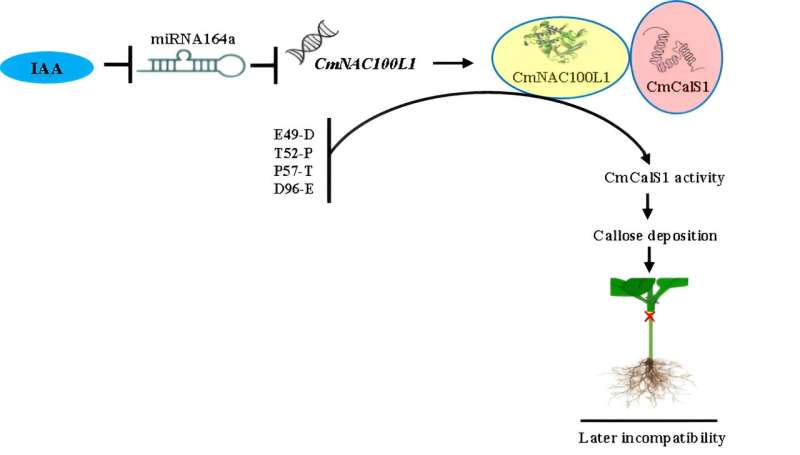Molecular regulatory pathways of symbiotic incompatibility of grafted seedlings regulated by IAA. Credit: Horticulture Research
Grafting is one of the key technologies to overcome the obstacles of continuous cropping, and improve crop yield and quality. However, the symbiotic incompatibility between rootstock and scion affects the normal growth and development of grafted seedlings after survival.
The specific molecular regulation mechanism of graft incompatibility is still largely unclear. In a study, appearing in Horticulture Research, researchers found that IAA-miR164a-NAC100L1 module induced callose deposition to mediate the symbiotic incompatibility of cucumber/pumpkin grafted seedlings.
The incompatible combination (IG) grafting interface accumulated more callose, and the activity of callose synthase (CmCalS1) and IAA content were significantly higher than those in compatible combination (CG).
Treatment with IAA polar transport inhibitor in the root of the IG plants decreased CmCalS activity and callose content. Furthermore, IAA negatively regulated the expression of Cm-miR164a, which directly targeted cleavage of CmNAC100L1.
Interestingly, CmNAC100L1 interacted with CmCalS1 to regulate its activity. Further analysis showed that the interaction between CmNAC100L1 and CmCalS1 in the IG plants enhanced, but decreased the activity of CmCalS1 in the CG plants.
Point mutation analysis revealed that threonine at the 57th position of CmCalS1 protein played a critical role to maintain its enzyme activity in the incompatible rootstock. Thus, IAA inhibited the expression of Cm-miR164a to elevate the expression of CmNAC100L1, which promoted CmNAC100L1 interaction with CmCalS1 to enhance CmCalS1 activity, resulting in callose deposition and symbiotic incompatibility of cucumber/pumpkin grafted seedlings.
More information: Mingzhu Yuan et al, IAA-miR164a-NAC100L1 module mediates symbiotic incompatibility of cucumber/pumpkin grafted seedlings through regulating callose deposition, Horticulture Research (2023). DOI: 10.1093/hr/uhad287
Journal information: Horticulture Research
Provided by Plant Phenomics























